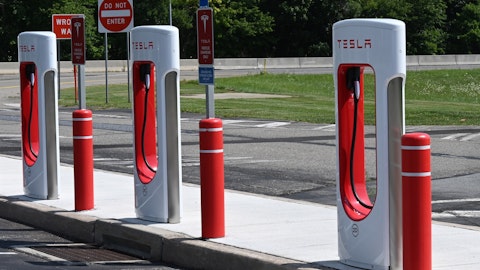Chris Pierce: Okay. Thank you.
Operator: Our next question comes from a line of Robert Jamieson with UBS. Please go ahead.
Robert Jamieson: Thank you for taking my questions. I just have a few here. So, first, with your deep and broad customer base, I’m just curious, like, with the conservatism from the CFOs, are you seeing any kind of headwinds or pressure from like the site preparation side where maybe the initial installments weren’t as costly and now it’s becoming a little bit harder to install? Is that anything that’s maybe been pressuring demand?
Rick Wilmer: No, I haven’t seen any pullback there, but I think in commercial, obviously, the total cost of ownership, which includes not only the chargers, but the installation is something that’s being considered by the financial decision makers in the commercial space.
Robert Jamieson: Okay. And then, just from the comments that you all have shared, and I appreciate the color, just curious, I mean, is your top line becoming a little bit more correlated to near-term deliveries. And it’s kind of what I digest most of the commentary as. And if that’s the case, do you expect this as like a near-term kind of headwind and then longer-term, obviously, the trends are still positive from a growth standpoint, but just curious, any thoughts there?
Mansi Khetani: Yes. It will be — we’ve talked about this before. We’ve had linearity as an issue. A majority of the shipments in the quarter happened within the last two weeks. And it’s not that much transactional, but at that point in time, if for example on the fleet side, if our customers want to push out delivery, it gets pushed out in literally the last week. And so, to that extent, we do get a little blindsided even though these are contracts that we’ve already won. We are on a mission to fix that. And we totally realized that having a more linear business will make our lives a lot easier. We will be able to forecast more efficiently. We’ll be able to plan our operation strategy in a better way. So, it’s more that back-end loaded kind of structure of our shipments that’s causing more of the uncertainty, which we are on our way to fix.
Robert Jamieson: Okay. No, that helps. And sorry, just one last one if I can squeeze it in. Just conceptually when you’re thinking about, and I’m not asking for guidance here, but when you’re talking about like the OpEx cuts that you’re going to have to make next year, how do you think about balancing in a high growth market, obviously your sales and marketing staff and conserving talent and keeping employees happy like, how do you think about balancing those items as you move forward when you’re going to be making some of these cuts?
Mansi Khetani: Again, we will give you a lot more color in the next call, but that is definitely top of mind. We need to balance a lot of things while we make these kind of decisions. We had to do the same thing in September and so this is top of mind. We are all evaluating all the nuances of every action. We have other levers like facilities costs, like external spend, like prioritizing our R&D, rollouts, prioritizing our sales and marketing, investments in areas where we see revenue today, et cetera, et cetera. So, a lot of significant, a lot of efficiency improvements that we’re constantly evaluating, but we will be able to give you more color at our next call.
Robert Jamieson: Got you. Thank you so much.
Operator: Our next question comes from a line of Shreyas Patil with Wolfe Research. Please go ahead.
Shreyas Patil: Hey, thanks a lot for taking my question. I appreciate the transparency. I guess, just on this issue of reliability of the chargers, I mean, how are you addressing the reality that you don’t own and operate the network, so you are having to ultimately either absorb cost of repair yourself, or you have to try and encourage the station owners to do that, and either that has to be done through some kind of payment or some model that you have to use to get them to do that. Just trying to understand how you could actually address some of the reliability issues as a result?
Rick Wilmer: Yes. So, in terms of covering a station that is subject to a problem after it’s been energized and it’s charged vehicles, we have a very rich suite of aftermarket service offerings that cover that for our customers. And it all depends on their specific use case with respect to the service level that we can provide. So, that, they pay for that as part of our services and support line on our P&L, and that’s a part of our recurring revenue. And that allows our customers to have peace of mind that their stations are going to be repaired and issues resolved quickly, but it also allows us to afford to do that for them.
Shreyas Patil: Okay. And maybe just on the material cost side, I think we had heard from prior management repeatedly about how new product introductions were going to result in significant cost reduction initiatives or significant cost reduction opportunities. And it doesn’t seem to be actually happening. I mean, the numbers don’t seem to suggest that there has been material cost savings. So, I’m trying to understand how to frame the kind of magnitude of savings you could realize from either this new supply chain strategy or the new product introductions that you talked about that have flown through?
Rick Wilmer: I can assure you they’re worth pursuing. And part of the timing on this is related to our inventory position. We need to work through that inventory, not only that we have on hand, but that’s in the supply chain before we can enjoy lower costs on both piece parts themselves, as well as the manufacturing value add that we are charged by our manufacturing partners. This is why we’ve indicated that by the time we get to the end of 2024, we will be very cost optimized around product cost.
Shreyas Patil: Okay, all right. Thank you.
Operator: Our next question comes from a line of Steven Fox with Fox Advisors, LLC. Please go ahead.
Steven Fox: Hi. Thanks for taking my question. I just had two clarifications. One, on the manufacturing strategy, would you say that there’s still in-house final assembly that the company is doing that they could also look at to reduce fixed costs? And then secondly, on the growth margins, I know you’re not talking specifically, but I would imagine there’s a benefit to growth margins as you flow through some low or no cost written down inventory through the income statement in coming quarters. Is that a reasonable assumption? Thanks.
Rick Wilmer: So, let me take the first-half of that, Steven. In terms of in-house assembly, we do very little of that, but one core tenant of our product design principle is around the concept of modularity. This is very important for inventory and working capital management. Essentially, what that means is, even though we have a myriad of configurations that a customer can order. For example, you can have different lengths of cables, you can have max connectors, you can have all kinds of different configurations in the product itself. We do all that in a very modular way which allows us to stock relatively generic inventory which helps us to keep our inventory position down and our working capital up. I’ll let Mansi take the second-half of that question.



